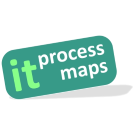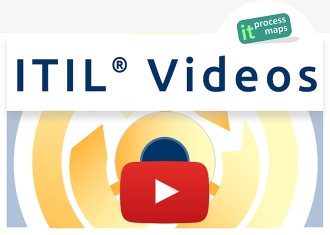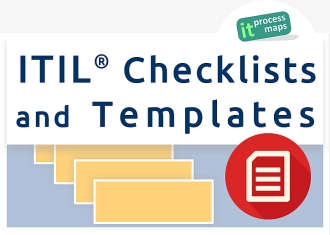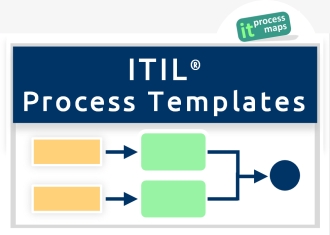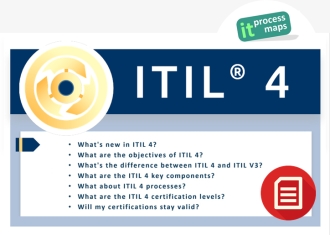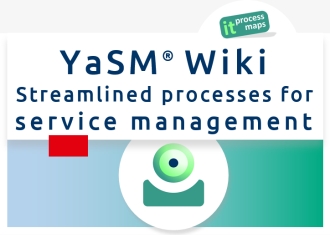ITIL Implementation - Process Design: Difference between revisions
No edit summary |
|||
| Line 1: | Line 1: | ||
<seo metakeywords="itil process design, itil process flow" metadescription="ITIL Process Design - Designing ITIL Processes ... | <seo metakeywords="itil process design, itil process flow" metadescription="ITIL Process Design - Designing ITIL Processes ... the result is documented in the form of detailed process flow diagrams." /> | ||
<imagemap> | <imagemap> | ||
Image:ITIL-Wiki-de-es.jpg|DE - ES - ITIL Process Design - Designing the ITIL Processes|100px | Image:ITIL-Wiki-de-es.jpg|DE - ES - ITIL Process Design - Designing the ITIL Processes|100px | ||
| Line 21: | Line 21: | ||
==== Objective of this Project Step ==== | ==== Objective of this Project Step ==== | ||
[[Image:Thumb-itil-process-flow.jpg|frame|right|alt=ITIL process design| | [[Image:Thumb-itil-process-flow.jpg|frame|right|alt=ITIL process design|Fig. 1: Detailed Process Descriptions (ITIL process flows)]] | ||
* Detailed definition of the individual activities within the ITIL processes ("ITIL process flows") | * Detailed definition of the individual activities within the ITIL processes ("ITIL process flows") | ||
* Definition of guidelines/ checklists to support process execution | * Definition of guidelines/ checklists to support process execution | ||
| Line 30: | Line 30: | ||
==== Description ==== | ==== Description ==== | ||
The detailed activities within the individual processes must be discussed with all relevant parties, in order to include into the design as much experience and knowledge as possible. The [[Roles | The detailed activities within the individual processes must be discussed with all relevant parties, in order to include into the design as much experience and knowledge as possible. The [[ITIL Roles#Process Owner|Process Owner]] is responsible for this task. | ||
As a result, a consensus must be reached and documented in the form of detailed ''process flow diagrams''. | As a result, a consensus must be reached and documented in the form of detailed ''process flow diagrams'' ''(see Fig. 1: [[Media:Thumb-itil-process-flow.jpg|ITIL process flows]])''. | ||
The framework of process structure and interfaces for this task was set up within the previous project steps: Due to the prior definition of the project interfaces, it is already established upon which inputs a process may build, and which results it must deliver for successive processes. With this information clearly specified it becomes much easier to define a process flow in a simple, straightforward way. | The framework of process structure and interfaces for this task was set up within the previous project steps: Due to the prior definition of the project interfaces, it is already established upon which inputs a process may build, and which results it must deliver for successive processes. With this information clearly specified it becomes much easier to define a process flow in a simple, straightforward way. | ||
| Line 59: | Line 59: | ||
==== Success Factors ==== | ==== Success Factors ==== | ||
* | * Process descriptions should give a clear idea of the required activities and their sequential order, but too many details should be avoided. Too much detail usually means that these documents are soon out of date, as they are too bulky to be an effective tool for the Process Owners. | ||
* It is recommended to confine further details into linked documents (e. g. guidelines and definitions of process outputs). | * It is recommended to confine further details into linked documents (e. g. guidelines and definitions of process outputs). | ||
| Line 67: | Line 67: | ||
<p> </p> | <p> </p> | ||
==== <span style="color:#5d5d5d">Relevant Views of the ITIL Process Map | ==== <span style="color:#5d5d5d">Relevant Views of the ITIL Process Map</span>==== | ||
[[Image: | <span style="color:#5d5d5d">Being well prepared is essential at this point in order to avoid the risk of producing a large number of uncorrelated and oversized documents.</span> | ||
<span style="color:#5d5d5d">The [https://en.it-processmaps.com/products/itil-process-map.html ITIL Process Map | |||
<span style="color:#5d5d5d">This is why our method of "ITIL Implementation Using ITIL Process Templates" takes great care to set up a framework of process structure and interfaces during the initial project steps. Due to the prior definition of the project interfaces, it is already established upon which inputs a process may build, and which results it must deliver for successive processes.</span> | |||
<span style="color:#5d5d5d">With this information clearly specified it becomes much easier to define a process flow in a simple, straightforward way.</span> | |||
<p> </p> | |||
[[Image:Itil-templates.jpg|thumb|400px|right|alt=ITIL templates and checklists|Figure 2: ITIL templates and checklists are used to enhance the ITIL process flows]] | |||
<span style="color:#5d5d5d">The [https://en.it-processmaps.com/products/itil-process-map.html ITIL Process Map] makes detailed process flows available for all ITIL processes ''(see Fig. 1: [[Media:Thumb-itil-process-flow.jpg|ITIL process flows]])''. These models fulfill the requirements of ITIL and ISO 20000.</span> | |||
<span style="color:#5d5d5d">Modifications will often be necessary to allow for special circumstances or preferences; these alterations are of course permitted, as long as the ITIL guiding ideas are followed.</span> | <span style="color:#5d5d5d">Modifications will often be necessary to allow for special circumstances or preferences; these alterations are of course permitted, as long as the ITIL guiding ideas are followed.</span> | ||
<span style="color:#5d5d5d">As an addition to the detailed ITIL process flows, checklists/ document templates ''(see | <span style="color:#5d5d5d">As an addition to the detailed ITIL process flows, checklists/ document templates ''(see Fig. 2)'' are available within the ITIL Process Map, describing procedures or process outputs in detail where necessary.</span> | ||
<span style="color:#5d5d5d">We make samples of our ITIL document templates and checklists ''(see Fig. 2: [[Media:Itil-templates.jpg|ITIL templates]])'' available for you in this IT Process Wiki:</span> | |||
→ [[ITIL-Checklists#The most sought-after ITIL | → [[ITIL-Checklists#ITIL 2011 Templates|"The most sought-after ITIL 2011 templates"]]. | ||
<p> </p> | |||
==== Resources ==== | |||
* [1] [[ITIL-Checklists|Detailed ITIL templates and checklists]] for defining ITIL process outputs and inputs | |||
* [2] More on [[ITIL Implementation with Process Templates|ITIL implementation with process templates]] | |||
* [3] [https://en.it-processmaps.com/general/faq.html FAQ: ITIL reference processes]; IT Process Maps. | |||
* [4] Structure and contents of an ITIL process model: [https://demo.it-processmaps.com/visio_en/itil-process-map.html Video: Introduction - ITIL Process Map]; IT Process Maps. | |||
* [5] Business Process Model and Notation (BPMN) version 2.0 - Specification, as of January 2011: [http://www.omg.org/spec/BPMN/2.0/ www.omg.org/spec/BPMN/2.0] and [http://bpmnhandbook.com/01_specs/BPMN_20_spec.pdf BPMN_20_spec.pdf] | |||
<p> </p> | <p> </p> | ||
| Line 82: | Line 101: | ||
'''Following Project Activity''' | '''Following Project Activity''' | ||
→ ITIL Implementation - Step 9: '''[[ITIL Implementation - | → ITIL Implementation - Step 9: '''[[ITIL Implementation - Application Systems|Selection and Implementation of Application Systems]]''' | ||
<p> </p> | <p> </p> | ||
<html><a rel="author" href="https://plus.google.com/113316270668629760475"><img style="margin:0px 0px 0px 0px;" src="/skins/Vector/images/itpm/bookmarking/gplus.png" width="16" height="16" title="By: Andrea Kempter | Profile on Google+" alt="Author: Andrea Kempter, IT Process Maps GbR" /></a></html> | |||
<!-- This page is assigned to the following categories: --> | <!-- This page is assigned to the following categories: --> | ||
[[Category:ITIL V3]][[Category:ITIL implementation]] | [[Category:ITIL V3]][[Category:ITIL 2011]][[Category:ITIL implementation]] | ||
<!-- --- --> | <!-- --- --> | ||
Revision as of 11:19, 30 June 2013
<seo metakeywords="itil process design, itil process flow" metadescription="ITIL Process Design - Designing ITIL Processes ... the result is documented in the form of detailed process flow diagrams." />

| Step 8: Designing the ITIL Processes in Detail |
Determining the sequences of single activities within each process is bound to be relatively labor-intensive. This makes it very important to concentrate on the areas which really matter.
Objective of this Project Step
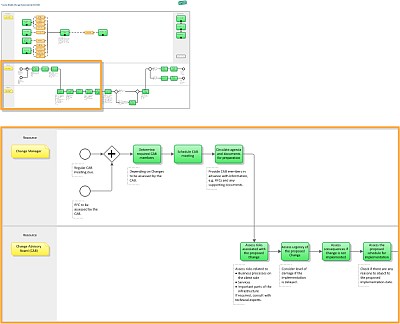
- Detailed definition of the individual activities within the ITIL processes ("ITIL process flows")
- Definition of guidelines/ checklists to support process execution
- Detailed definition of the process outputs
Description
The detailed activities within the individual processes must be discussed with all relevant parties, in order to include into the design as much experience and knowledge as possible. The Process Owner is responsible for this task.
As a result, a consensus must be reached and documented in the form of detailed process flow diagrams (see Fig. 1: ITIL process flows).
The framework of process structure and interfaces for this task was set up within the previous project steps: Due to the prior definition of the project interfaces, it is already established upon which inputs a process may build, and which results it must deliver for successive processes. With this information clearly specified it becomes much easier to define a process flow in a simple, straightforward way.
Additional information to facilitate the process execution, describing procedures or deliverables in detail, can be added in the form of linked checklists/ document templates. For example there could be a couple of extra pages describing what sort of information is to be collected during the initial registration of an Incident.
Prerequisites
- Structure of the Service Management processes to be introduced
- Process overviews (process breakdown)
- Interfaces of the ITIL processes to be introduced
- Measures (KPIs) for the ITIL processes to be introduced
Results/ Deliverables
- Detailed process descriptions in the form of Activity Chains
- Guidelines/ checklists
- Definitions of the process outputs
Success Factors
- Process descriptions should give a clear idea of the required activities and their sequential order, but too many details should be avoided. Too much detail usually means that these documents are soon out of date, as they are too bulky to be an effective tool for the Process Owners.
- It is recommended to confine further details into linked documents (e. g. guidelines and definitions of process outputs).
- It is decisive for a successful process implementation to include all the relevant parties in this phase of the project, in order to make use of their wide range of experiences from daily business, and to ensure that the redesigned processes will be accepted and adhered to.
Relevant Views of the ITIL Process Map
Being well prepared is essential at this point in order to avoid the risk of producing a large number of uncorrelated and oversized documents.
This is why our method of "ITIL Implementation Using ITIL Process Templates" takes great care to set up a framework of process structure and interfaces during the initial project steps. Due to the prior definition of the project interfaces, it is already established upon which inputs a process may build, and which results it must deliver for successive processes.
With this information clearly specified it becomes much easier to define a process flow in a simple, straightforward way.
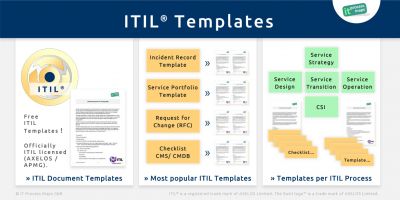
The ITIL Process Map makes detailed process flows available for all ITIL processes (see Fig. 1: ITIL process flows). These models fulfill the requirements of ITIL and ISO 20000.
Modifications will often be necessary to allow for special circumstances or preferences; these alterations are of course permitted, as long as the ITIL guiding ideas are followed.
As an addition to the detailed ITIL process flows, checklists/ document templates (see Fig. 2) are available within the ITIL Process Map, describing procedures or process outputs in detail where necessary.
We make samples of our ITIL document templates and checklists (see Fig. 2: ITIL templates) available for you in this IT Process Wiki:
→ "The most sought-after ITIL 2011 templates".
Resources
- [1] Detailed ITIL templates and checklists for defining ITIL process outputs and inputs
- [2] More on ITIL implementation with process templates
- [3] FAQ: ITIL reference processes; IT Process Maps.
- [4] Structure and contents of an ITIL process model: Video: Introduction - ITIL Process Map; IT Process Maps.
- [5] Business Process Model and Notation (BPMN) version 2.0 - Specification, as of January 2011: www.omg.org/spec/BPMN/2.0 and BPMN_20_spec.pdf
Following Project Activity
→ ITIL Implementation - Step 9: Selection and Implementation of Application Systems
